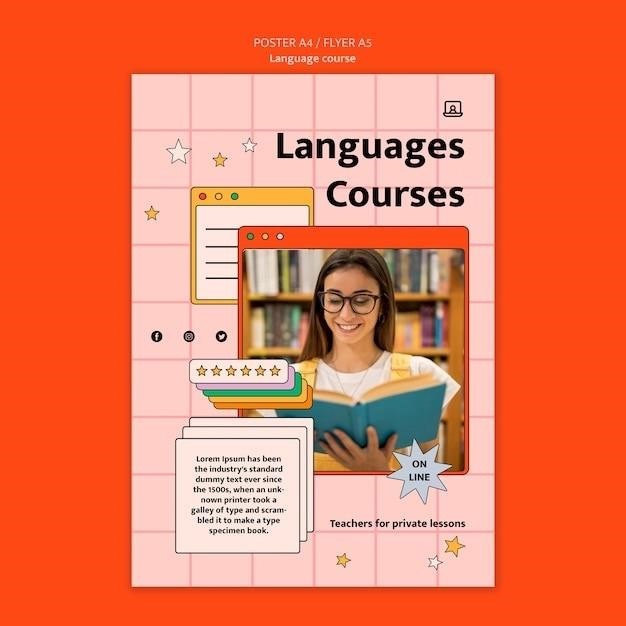The eukaryotic cell cycle is a highly regulated process ensuring cell growth, DNA replication, and division․ It consists of four phases: G1, S, G2, and M․ Proper regulation is crucial for maintaining genomic stability, with dysregulation often leading to cancer․
1․1․ Overview of the Cell Cycle
The eukaryotic cell cycle is a sequential process of cell growth, DNA replication, and cell division․ It includes four distinct phases: Gap 1 (G1), Synthesis (S), Gap 2 (G2), and Mitosis (M)․ The G1 phase prepares the cell for DNA replication, while the S phase involves DNA synthesis․ The G2 phase ensures the cell is ready for mitosis, where chromosomes are duplicated and distributed to daughter cells․ Checkpoints regulate each phase to ensure accuracy and prevent errors․ Dysregulation of the cell cycle can lead to uncontrolled cell growth, a hallmark of cancer․ Understanding the cell cycle is crucial for studying cancer development and developing targeted therapies․
1․2․ Importance of the Cell Cycle in Eukaryotic Organisms

The cell cycle is essential for the survival and development of eukaryotic organisms․ It enables growth through cell division, replacing damaged or aged cells, and repairing tissues․ In multicellular organisms, it supports development and tissue renewal․ Dysregulation can lead to cancer, emphasizing its critical role in maintaining health․ Proper cell cycle regulation ensures genomic stability, preventing mutations that could cause disease․ Thus, understanding the cell cycle is vital for advancements in medicine, particularly in cancer research and treatment development․
1․3․ Phases of the Eukaryotic Cell Cycle
The eukaryotic cell cycle consists of four distinct phases: G1, S, G2, and M․ The G1 phase involves cell growth and preparation for DNA replication․ During the S phase, DNA replication occurs, ensuring genetic material is duplicated․ The G2 phase allows the cell to prepare for mitosis by producing necessary proteins․ Finally, the M phase includes mitosis and cytokinesis, where the cell divides into two daughter cells․ These phases are tightly regulated to ensure proper cell division and maintain genomic integrity․ Dysregulation of these phases can lead to uncontrolled cell growth, a hallmark of cancer, emphasizing the importance of understanding these processes․

The Four Phases of the Eukaryotic Cell Cycle
The eukaryotic cell cycle includes four phases: G1, S, G2, and M, each with unique roles in cell growth, DNA replication, and division․
2․1․ Gap 1 (G1 Phase)

The G1 phase is the first stage of the eukaryotic cell cycle, occurring after cell division․ During this phase, the cell grows, accumulates nutrients, and prepares for DNA replication in the S phase․ It is a critical period where the cell assesses its environment and integrity, deciding whether to proceed with division, pause, or initiate apoptosis․ Key molecular checks, such as the G1/S checkpoint, ensure that damaged cells do not replicate․ Dysregulation of the G1 phase, often due to mutations in tumor suppressor genes like p53, can lead to unchecked cell proliferation, a hallmark of cancer․ This phase’s proper regulation is vital for preventing genomic instability and tumor formation․
2․2․ Synthesis (S Phase)
The S phase is the second stage of the eukaryotic cell cycle, during which DNA replication occurs․ Each chromosome is replicated, forming two identical sister chromatids․ This phase ensures genetic continuity, as the replicated DNA is essential for cell division․ The S phase is tightly regulated to prevent errors, with mechanisms like DNA repair systems and checkpoints ensuring replication fidelity․ Errors during this phase, such as mutations or incomplete replication, can lead to genomic instability․ In cancer, mutations in genes regulating the S phase, like p53 or BRCA1, can result in uncontrolled DNA replication and tumor formation․ Proper regulation of the S phase is critical for maintaining cellular and organismal health․
2․3․ Gap 2 (G2 Phase)
The G2 phase is the second gap phase, following DNA synthesis and preceding mitosis․ During this phase, the cell prepares for division by producing organelles and proteins essential for mitosis․ It also serves as a critical checkpoint where the cell verifies the accuracy of DNA replication and repairs any damage․ If DNA errors are detected, the cell can either repair them or, if beyond repair, undergo apoptosis to prevent potential mutations․ In cancer, mutations in checkpoint genes can lead to bypass of this phase, allowing cells with damaged DNA to divide uncontrollably․ Thus, the G2 phase plays a pivotal role in maintaining genomic integrity and preventing cancer development․
2․4․ Mitosis (M Phase)
Mitosis is the most recognizable phase of the cell cycle, where the replicated chromosomes are evenly divided between two daughter cells․ It consists of four stages: prophase, metaphase, anaphase, and telophase․ During prophase, chromatin condenses into visible chromosomes, and the mitotic spindle forms․ Metaphase aligns chromosomes at the cell’s center, ensuring each daughter cell receives identical genetic material․ Anaphase separates sister chromatids, while telophase reverses prophase changes, reforming nuclei․ Proper mitotic regulation is crucial; errors can lead to aneuploidy, a hallmark of cancer․ Mutations in mitotic checkpoint genes disrupt this process, contributing to genomic instability and cancer progression․ Thus, mitosis is a tightly controlled phase critical for cellular health and cancer prevention․
Regulation of the Cell Cycle
The cell cycle is tightly regulated by cyclin-dependent kinases (CDKs) and cyclins, which drive progression through checkpoints․ Inhibitors and checkpoints ensure proper cell division, preventing cancer․
3․1․ Role of Cyclin-Dependent Kinases (CDKs)
Cyclin-Dependent Kinases (CDKs) are essential enzymes that regulate cell cycle progression by phosphorylating key substrates․ They bind to specific cyclins, which activate their kinase activity, driving the cell through checkpoints․ CDKs ensure proper transitions between phases, such as G1 to S and G2 to M․ Dysregulation of CDK activity, often due to mutations in regulatory genes, can lead to uncontrolled cell division and cancer․ Inhibitors targeting CDKs are a promising therapeutic strategy in cancer treatment, highlighting their critical role in maintaining cell cycle control․
3;2․ Function of Cyclins in Cell Cycle Progression
Cyclins are regulatory proteins that activate Cyclin-Dependent Kinases (CDKs), driving cell cycle progression; Different cyclins bind to specific CDKs, ensuring the cell transitions through phases accurately․ For instance, Cyclin D binds CDK4/6 in G1, promoting entry into the cell cycle, while Cyclin B binds CDK1 during mitosis․ Cyclins are tightly regulated, with their synthesis and degradation ensuring proper timing of cell cycle events․ Abnormal cyclin expression or activity disrupts these checkpoints, contributing to uncontrolled cell growth and cancer development․ Targeting cyclin-CDK complexes is a key strategy in cancer therapy, aiming to halt the excessive proliferation of cancer cells․
3․3․ Cell Cycle Inhibitors and Their Mechanisms
Cell cycle inhibitors are proteins that halt or slow cell cycle progression, ensuring proper DNA repair or preventing uncontrolled division․ Key inhibitors include p27, p21, and the Retinoblastoma (Rb) protein․ These proteins bind to Cyclin-Dependent Kinases (CDKs) or block their activation, halting the cell cycle at specific checkpoints․ For example, p21 inhibits CDK2 and CDK4, preventing G1/S progression, while Rb binds E2F transcription factors, blocking S-phase entry․ Mutations in these inhibitors disrupt cell cycle control, leading to cancer․ Restoring or targeting these pathways is a critical strategy in cancer therapy, aiming to halt tumor growth by reactivating natural cell cycle brakes․
Cell Cycle Checkpoints
Cell cycle checkpoints monitor and halt progression to allow DNA repair or resolve errors, ensuring proper division․ Their failure can lead to uncontrolled cell growth and cancer․
4․1․ G1/S Checkpoint: Ensuring Cell Readiness for DNA Replication
The G1/S checkpoint is a critical regulatory point ensuring cells are ready to enter the S phase, where DNA replication occurs․ During this checkpoint, the cell evaluates its size, nutrient availability, and DNA integrity․ If conditions are favorable, the checkpoint is bypassed, allowing progression into the S phase․ Key regulatory proteins, such as p53 and the retinoblastoma protein (Rb), play essential roles in this process․ p53 can initiate DNA repair or apoptosis if damage is detected, while Rb ensures that cells are adequately prepared for replication․ Dysregulation of this checkpoint is a common feature in cancer, leading to unchecked cell proliferation․
4․2․ G2/M Checkpoint: Preparing for Mitosis
The G2/M checkpoint acts as a final quality-control mechanism before mitosis, ensuring that DNA replication is complete and any damage is repaired․ This checkpoint prevents cells with damaged or incomplete DNA from entering mitosis, thereby maintaining genomic integrity․ Key regulatory proteins, such as p53 and the ATM/ATR kinases, are central to this process․ If DNA damage is detected, these proteins can trigger repair mechanisms or apoptosis․ Dysregulation of the G2/M checkpoint allows damaged cells to progress through the cell cycle, contributing to mutations and cancer development․ This checkpoint is critical for preventing the propagation of genetic errors and ensuring proper cell division․
4․3․ Mitotic Checkpoint: Ensuring Proper Chromosome Segregation
The mitotic checkpoint ensures proper chromosome segregation during mitosis by verifying that all chromosomes are correctly attached to spindle fibers․ This checkpoint prevents anaphase initiation until all kinetochores are properly bound, ensuring accurate chromosome distribution․ Key proteins like Bub1, BubR1, and Aurora kinases monitor and regulate this process․ Failure of the mitotic checkpoint can lead to chromosomal instability, a hallmark of cancer․ In cancer cells, defects in this checkpoint often result in aneuploidy, promoting tumorigenesis․ The mitotic checkpoint acts as a fail-safe mechanism to maintain genomic integrity, and its dysregulation is a common feature in many cancers, contributing to mutations and uncontrolled cell growth․
Cancer and the Cell Cycle
Cancer arises from dysregulation of the cell cycle, often due to mutations in genes controlling cell division and death, leading to uncontrolled growth and tumor formation․
5․1․ The Relationship Between Unregulated Cell Division and Cancer
Unregulated cell division is a hallmark of cancer, arising from mutations in genes that control the cell cycle, such as tumor suppressors and proto-oncogenes․ These mutations disrupt normal checkpoints, allowing cells to bypass mechanisms that prevent uncontrolled growth․ For instance, mutations in the p53 gene impair its ability to initiate apoptosis or arrest the cell cycle in response to DNA damage․ Similarly, hyperactivation of proto-oncogenes drives excessive cell proliferation․ This dysregulation leads to the formation of tumors and cancer progression, as cells evade growth-inhibitory signals and apoptotic pathways․ The loss of cell cycle control is a critical step in the development and progression of malignancy․
5․2․ Role of Proto-Oncogenes and Tumor Suppressor Genes
Proto-oncogenes and tumor suppressor genes play critical roles in regulating the cell cycle․ Proto-oncogenes, such as Ras and MYC, promote cell growth and division when activated․ However, mutations can convert them into oncogenes, leading to excessive cell proliferation․ Tumor suppressor genes, like p53 and Rb, act as brakes on the cell cycle, preventing uncontrolled division or initiating apoptosis in damaged cells․ Mutations in these genes disrupt their protective functions, allowing cells to bypass checkpoints and proliferate uncontrollably, contributing to cancer development․ The interplay between these genes ensures proper cell cycle regulation, and their dysregulation is a key driver of tumorigenesis․

5․3․ Common Mutations Leading to Cancer
Common mutations in genes like p53, Rb, and APC disrupt cell cycle regulation, leading to cancer․ p53 mutations impair DNA damage repair, allowing cells with genetic errors to proliferate․ Rb mutations remove a critical checkpoint, enabling unchecked progression through the cell cycle․ APC mutations prevent the degradation of beta-catenin, promoting uncontrolled cell growth․ These mutations accumulate over time, bypassing safeguards like apoptosis and cell cycle arrest․ Such genetic alterations are frequently observed in cancers, including colorectal, breast, and lung cancers, highlighting their central role in tumorigenesis․ These mutations exemplify how disruptions in key regulatory pathways can drive the transition from normal cell behavior to malignancy․

Key Proteins in Cell Cycle Regulation and Cancer
Proteins like p53, Rb, and APC play pivotal roles in cell cycle regulation․ p53 ensures genomic stability, Rb controls G1/S transition, and APC regulates beta-catenin, preventing uncontrolled cell growth․
6․1․ The Role of p53 in Maintaining Genomic Stability
The p53 protein is a critical tumor suppressor that ensures genomic stability by monitoring cellular stress and DNA damage․ Activated during cell cycle checkpoints, p53 halts the cycle to allow DNA repair or induces apoptosis if damage is irreparable․ It regulates genes involved in cell cycle arrest, DNA repair, and apoptosis, preventing the propagation of mutations․ Mutations in p53 are common in cancers, leading to unchecked cell proliferation and tumor formation․ Thus, p53 acts as a guardian of the genome, maintaining cellular integrity and preventing cancer development through its regulatory functions․
6․2․ The Retinoblastoma (Rb) Protein: A Tumor Suppressor
The Retinoblastoma (Rb) protein is a key tumor suppressor that regulates cell cycle progression․ It binds to and inhibits E2F transcription factors, preventing the transcription of genes required for DNA synthesis and cell division․ When phosphorylated by Cyclin-CDK complexes, Rb releases E2F, allowing cell cycle progression․ Mutations or inactivation of the Rb gene lead to uncontrolled cell proliferation, contributing to cancers such as retinoblastoma and other tumors․ The Rb protein ensures proper cell cycle regulation, acting as a critical checkpoint to prevent oncogenic transformation and maintain genomic stability․
6․3․ The APC Gene and Its Role in Cell Cycle Regulation
The APC gene encodes a tumor suppressor protein critical for regulating the cell cycle․ It functions by targeting β-catenin for degradation, preventing its accumulation and subsequent activation of pro-proliferative genes․ When the APC gene is mutated, β-catenin builds up, leading to uncontrolled cell division and tumor formation․ This is commonly observed in colorectal cancer, where APC mutations are a hallmark․ The APC protein also interacts with microtubules during mitosis, ensuring proper chromosome segregation․ Dysregulation of APC disrupts these processes, contributing to genomic instability and cancer progression․ Thus, the APC gene plays a pivotal role in maintaining cell cycle integrity and preventing neoplastic transformation․
Cancer Overview and Cell Cycle Dysregulation
Cancer arises from cell cycle dysregulation, leading to uncontrolled cell division and genetic instability․ Mutations in key regulators like p53 and APC contribute to tumor development and progression․
7․1․ How Cancer Arises from Cell Cycle Misregulation
Cancer emerges when the eukaryotic cell cycle is misregulated, leading to unchecked cell proliferation․ Mutations in tumor suppressor genes, such as p53, and proto-oncogenes disrupt normal cell cycle checkpoints․ These disruptions allow damaged cells to bypass critical regulatory mechanisms, enabling uncontrolled division․ The G1/S and G2/M checkpoints are particularly vulnerable, as their failure permits cells with damaged DNA to enter mitosis․ This results in genomic instability and the accumulation of mutations․ Over time, such cells evade apoptosis and acquire hallmarks of cancer, including sustained growth and metastasis․ The misregulation of cyclins and CDKs further exacerbates this process, highlighting the critical role of cell cycle control in preventing tumor formation and maintaining genomic integrity․
7․2․ The Role of Apoptosis in Preventing Cancer
Apoptosis, or programmed cell death, is a critical mechanism that prevents cancer by eliminating damaged or unwanted cells․ During the cell cycle, if DNA damage or anomalies are detected, apoptosis ensures these cells do not proliferate․ Proteins like p53 play a central role by activating pro-apoptotic genes when cell cycle checkpoints fail․ This prevents the propagation of mutations that could lead to cancer․ Dysregulation of apoptosis, often due to mutations in tumor suppressor genes, allows damaged cells to survive and potentially progress into malignancies․ Thus, apoptosis acts as a safeguard against cancer, maintaining tissue health and preventing uncontrolled cell growth․
7․3․ Consequences of Bypassing Cell Cycle Checkpoints
Bypassing cell cycle checkpoints allows damaged cells to progress through the cycle unchecked, leading to uncontrolled division and potential cancer development․ DNA damage may not be repaired, causing mutations to accumulate, which can activate oncogenes or inactivate tumor suppressor genes․ This genomic instability often results in abnormal cell behavior․ Additionally, bypassing checkpoints can prevent apoptosis, allowing defective cells to survive and proliferate․ Over time, this can lead to the formation of tumors and contribute to cancer progression․ Thus, the failure of cell cycle checkpoints is a critical factor in the development and propagation of cancer․

Therapeutic Targets in Cancer Treatment
Therapeutic strategies targeting Cyclin-CDK complexes and CDK inhibitors show promise in cancer treatment by halting uncontrolled cell division․ Restoring tumor suppressor functions also helps manage cancer growth effectively․
8․1․ Targeting CDKs in Cancer Therapy
Cyclin-dependent kinases (CDKs) are critical regulators of the cell cycle, making them attractive targets for cancer therapy․ Inhibiting CDKs can halt the uncontrolled proliferation of cancer cells by disrupting the G1/S and G2/M checkpoints․ Specific CDK inhibitors, such as Palbociclib, have shown efficacy in treating cancers like breast cancer by targeting CDK4/6, which are often hyperactive in tumor cells․ This approach selectively affects cancer cells while sparing healthy cells, reducing side effects․ Additionally, combining CDK inhibitors with other therapies enhances their effectiveness․ Mutations in genes like p53 and APC, which regulate CDK activity, are often exploited in cancer, making CDK inhibition a promising therapeutic strategy․
8․2․ Inhibiting Cyclin-CDK Complexes
Inhibiting cyclin-CDK complexes is a strategic approach to halting cancer progression․ These complexes drive cell cycle progression, and their dysregulation is a hallmark of cancer․ CDK inhibitors bind to these complexes, preventing their kinase activity and blocking cell cycle transitions․ For example, inhibitors like palbociclib target CDK4/6, which are often hyperactive in cancers such as breast cancer․ This inhibition leads to G1 arrest, preventing DNA replication and tumor growth․ Clinical trials have demonstrated the efficacy of these inhibitors in improving progression-free survival․ Additionally, combining CDK inhibitors with other therapies enhances their anti-tumor effects․ This targeted approach reduces toxicity compared to traditional chemotherapy, making it a promising cancer treatment strategy․
8․3․ Restoring Tumor Suppressor Function in Cancer Cells
Restoring tumor suppressor function is a critical strategy in cancer therapy․ Proteins like p53 and Rb are often inactivated in cancer, leading to unchecked cell proliferation․ Reactivating these proteins can halt tumor growth․ For instance, small molecules targeting mutant p53 can restore its ability to induce apoptosis and cell cycle arrest․ Similarly, therapies targeting the Rb pathway aim to re-establish cell cycle control․ Clinical trials are exploring such interventions, showing promise in certain cancers․ Additionally, gene therapy approaches aim to reintroduce functional copies of tumor suppressor genes․ These methods hold potential for treating cancers resistant to conventional treatments, offering targeted and effective solutions to restore cellular regulation and combat malignancy․

Specific Cancers and Cell Cycle Abnormalities
Certain cancers exhibit distinct cell cycle abnormalities․ Breast cancer often involves p53 mutations, while lung cancer frequently shows Rb protein dysregulation․ Colorectal cancer links to APC gene mutations․
9․1․ Breast Cancer and Cell Cycle Dysregulation

Breast cancer often involves mutations in key cell cycle regulatory genes, such as p53 and Rb․ These mutations disrupt normal cell cycle checkpoints, leading to unchecked cell division․ The p53 gene, a tumor suppressor, is frequently mutated in breast cancer, impairing its ability to arrest the cell cycle in response to DNA damage․ Similarly, mutations in the Rb gene, which regulates the G1/S checkpoint, allow cells to bypass this critical control point․ These abnormalities result in uncontrolled cell proliferation and tumor formation․ Additionally, dysregulation of cyclins and CDKs further exacerbates cell cycle progression, contributing to the aggressive nature of certain breast cancer subtypes․ This highlights the central role of cell cycle dysregulation in breast cancer development and progression․
9․2․ Lung Cancer and Mutations in Cell Cycle Regulators
Lung cancer is frequently associated with mutations in cell cycle regulatory proteins, particularly in genes like p53, Rb, and CDKN2A․ These mutations impair critical checkpoints, allowing damaged cells to bypass repair mechanisms and proliferate uncontrollably․ The p53 gene, a key tumor suppressor, is commonly mutated in lung cancer, leading to a failure in arresting the cell cycle after DNA damage․ Similarly, mutations in the Rb gene disrupt the G1/S checkpoint, enabling unchecked progression through the cell cycle․ Additionally, altered expression of cyclins and cyclin-dependent kinases (CDKs) further drives unregulated cell division․ These mutations contribute significantly to the aggressive nature of lung cancer and highlight the importance of targeting cell cycle regulators in therapeutic strategies․
9․3․ Colorectal Cancer and the APC Gene
Colorectal cancer is strongly linked to mutations in the APC gene, a key tumor suppressor involved in cell cycle regulation․ The APC gene plays a critical role in the Wnt signaling pathway, regulating β-catenin levels to prevent uncontrolled cell proliferation․ Mutations in APC disrupt this regulation, leading to β-catenin accumulation and subsequent activation of oncogenic genes․ This results in the formation of adenomas, which can progress to carcinomas if left unchecked․ APC mutations are among the earliest events in colorectal cancer development, highlighting the gene’s central role in tumor initiation and progression․ Restoring APC function or targeting downstream pathways remains a key focus in colorectal cancer therapy․

Future Directions in Cell Cycle Research and Cancer Therapy
Future research focuses on targeted therapies, checkpoint inhibitors, and personalized medicine to exploit cell cycle dysregulation in cancer, offering precise and effective treatments with minimal side effects․
10․1․ Advances in Targeted Cancer Therapies
Targeted therapies focus on specific molecules involved in cancer cell proliferation․ By inhibiting proteins like CDKs and cyclins, these treatments disrupt the cell cycle, halting tumor growth․ Advances include drugs that selectively target mutated genes, such as p53 and Rb, restoring their tumor-suppressing functions․ Additionally, therapies aimed at specific checkpoints, like the G1/S checkpoint, prevent cancer cells from entering the replication phase․ These approaches reduce harm to healthy cells, improving efficacy and reducing side effects․ Personalized medicine further tailors treatments based on individual genetic profiles, enhancing effectiveness․ Such innovations highlight the potential for more precise and less invasive cancer therapies in the future․
10․2․ The Potential of Checkpoint Inhibitors
Checkpoint inhibitors represent a groundbreaking approach in cancer therapy by targeting immune system regulators․ These drugs block proteins like PD-1 or CTLA-4, which cancer cells exploit to evade immune detection․ By inhibiting these checkpoints, the immune system, particularly T-cells, can more effectively identify and destroy cancer cells․ This approach has shown remarkable success in treating various cancers, offering improved survival rates and fewer side effects compared to traditional therapies․ Checkpoint inhibitors also enhance the body’s ability to recognize and attack cancer cells, making them a promising avenue for long-term cancer management and potential cures․
10․3․ Personalized Medicine in Cancer Treatment
Personalized medicine revolutionizes cancer therapy by tailoring treatments to individual patients’ genetic profiles․ Advanced genomic analysis identifies specific mutations driving a patient’s cancer, enabling targeted therapies․ This approach minimizes harm to healthy cells, improving efficacy and reducing side effects․ Biomarkers and precision diagnostics guide treatment selection, ensuring therapies are optimized for maximum impact․ Personalized medicine also facilitates the development of combination therapies, addressing cancer’s heterogeneity․ By integrating patient-specific data, this approach offers hope for more effective and less toxic treatments, transforming the landscape of oncology and improving patient outcomes significantly․






































